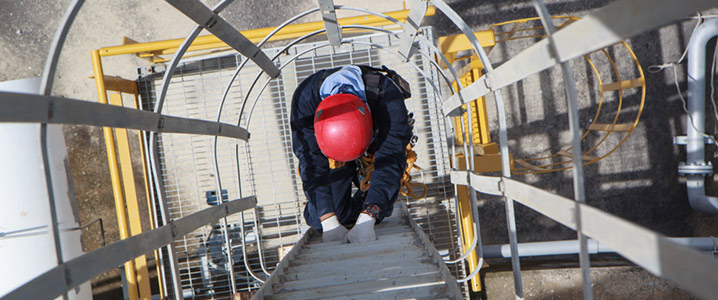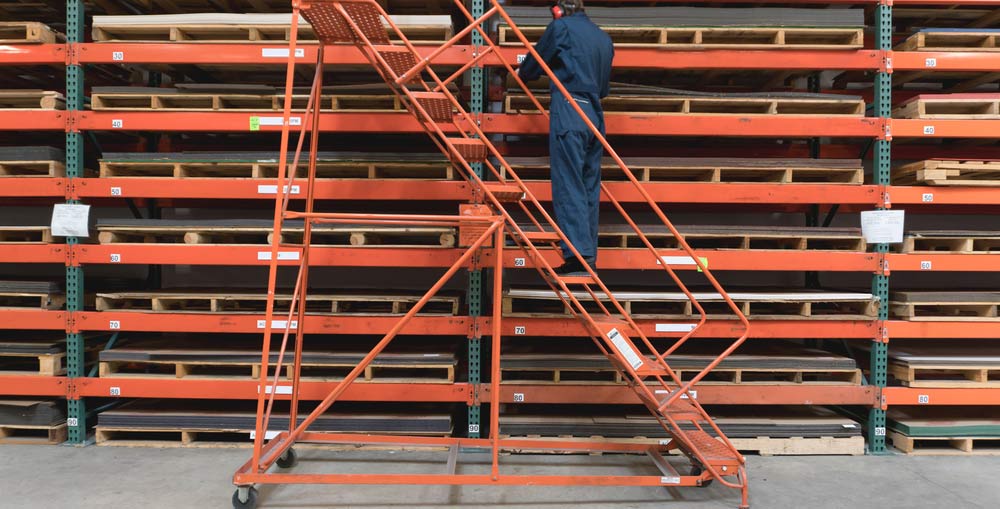OSHA ladder safety rules are a popular topic, and rightly so. Did you know that 20% of lost work-day and fatal workplace injuries are caused by ladder falls in general industry? This article attempts to cover some core ladder safety standards that can help keep your employees safe while avoiding OSHA fines and penalties.
OSHA Ladder Regulations
Title 29 Code of Federal Regulations (CFR) Part 1910.23 helps break down OSHA guidelines for ladders on a high level. 29 CFR 1910.23 covers the application of its rules, general requirements for all ladders (minus those used in rescue, firefighting, and tactical law enforcement), and specifics about fixed ladders, portable ladders, and mobile ladder stands and platforms.
Fixed Ladders
Fixed ladders generally are permanently secured to equipment, buildings, and structures. Ladder steps need to be seven inches from the object they’re mounted to, and grab bars must extend three and a half feet above the above surface to which they lead.
Portable Ladders
Portable ladders refer to side rails with rungs, steps, or cleats joining them. This can include self-supporting variants or ladders that must lean against a structure. The steps need to have skid-resistant material or design and some locking mechanism to ensure the ladder system doesn’t adjust while someone is using it.
Mobile Ladder Stands and Mobile Ladder Stand Platforms
Mobile ladder stands and platforms must be slip-resistant and capable of supporting four times their max load. In addition, these ladders cannot move while employees are on them, and the base frame must encompass the standing area of the mobile ladder system.

Top 5 OSHA Ladder Safety Tips
Now that we’ve covered some of the types of ladders OSHA recognizes, how can employers ensure that employees use them safely? Below, we cover five crucial ladder safety guidelines and their corresponding OSHA ladder safety rules and standards from 29 CFR 1910.23 and 29 CFR 1926.1053.
1. Ladder Maintenance
Whose responsibility is it to keep ladders in good condition? Hint – it’s not up to each employee. The ladder safety guidelines within your organization should include a system for inspecting and maintaining ladders and taking them out of commission when necessary.
The following OSHA ladder inspection requirements are specified in their safety standards.
1926.1053(b)(2) – Ladders shall be maintained free of oil, grease, and other slipping hazards.
1926.1053(b)(15) – Ladders shall be inspected by a competent person for visible defects periodically and after any occurrence that could affect their safe use.
1926.1053(b)(17) – Fixed ladders with structural defects, including broken or missing rungs, cleats, or steps, broken or split rails, or corroded components, shall be withdrawn from service until repaired.
1910.23(b)(5) – Wooden ladders are not coated with any material that may obscure structural defects.
1910.23(b)(9) – Ladders are inspected before initial use in each work shift and more frequently as necessary to identify any visible defects that could cause employee injury.
1910.23(b)(10) – Any ladder with structural or other defects is immediately tagged “Dangerous: Do Not Use” or with similar language per § 1910.145 and removed from service until repaired per § 1910.22(d) or replaced.
2. Ladder Weight Limits
Safe ladder use per OSHA typically involves some weight parameters. Therefore, OSHA ladder weight requirements are usually described at limits or multiples of the weight ratings and classifications ladder manufacturers assign to each unit.
In regards to “ladder safety devices, and related support systems, for fixed ladders,” the following OSHA regulation applies:
1926.1053(a)(22)(i) – They shall be capable of withstanding without failure a drop test consisting of an 18-inch (41 cm) drop of a 500-pound (226 kg) weight.
1910.23(c)(3) – Ladders are not loaded beyond the maximum intended load.
The “load” in this standard refers to the entire eight comprised of all employee equipment, tools, and materials.
3. Practice Basic Ladder Safety
Climbing ladders at work can be a relatively safe endeavor if your employees use common sense. However, OSHA frequently includes standards for safety items that should go without saying. The following criteria cover fall protection safety requirements that should seem pretty intuitive.
1926.1053(b)(4) – Ladders shall be used only for the purpose they were designed.
1910.23(c)(4) – Ladders are used only on stable and level surfaces unless secured or stabilized to prevent accidental displacement.
1910.23(c)(6) – No ladder is moved, shifted, or extended while an employee is on it.
1910.23(c)(9) – Portable ladders are secured and stabilized on slippery surfaces.
4. Ladder Climbing Practices
While creativity in the workplace can frequently be a source of value, it should be actively discouraged while climbing ladders. OSHA ladder training requirements say you must reinforce the following instructions to your employees.
1910.23(b)(11) – Each employee faces the ladder when climbing up or down it.
1910.23(b)(12) – Each employee uses at least one hand to grasp the ladder when climbing up and down it.
1926.1053(b)(22) – An employee shall not carry any object or load that could cause the employee to lose balance and fall.
5. Ladder Extension Limits
For proper ladder safety training, ensure your employees follow extension guidelines for combination ladders, portable ladders, and fixed ladders that provide access to an elevated surface.
1926.1053(a)(21)(iii) – Their inside face on the climbing side of the ladder shall extend not less than 27 inches (68 cm) nor more than 30 inches (76 cm) from the centerline of the step or rung.
1910.23(c)(11) – Portable ladders used to gain access to an upper landing surface have side rails that extend at least 3 feet (0.9 m) above the upper landing surface.

Safety By Design Offers Ladder Safety Training in Houston
It can be challenging to keep up with every detail about OSHA ladder rules. Many times, avoiding unsafe ladder use is as easy as using some common sense. Other times, the OSHA ladder safety rules can be difficult to remember.
The Houston safety training available at Safety By Design can be tailored to include the most high-risk activities at your organization. If you’re concerned that you don’t even know what you don’t know about ladder safety, our safety compliance management services are right for you. Our safety staffing services can help you identify which of your safety processes aren’t compliant and how to improve their compliance and safety for a healthier workplace.
Contact us today to speak with a team member about how we can best serve your Texas workplace.
| Thank you for visiting our website! We appreciate your interest in workplace safety. Please note that Safety by Design is not affiliated with OSHA. However, we can assist you with the following OSHA-related services: • OSHA Mock Inspection • OSHA Training • Facilitate OSHA Inspections and Citations If you need to file a complaint with OSHA, please call 800-321-6742 (OSHA) or visit this page for other methods to contact them. |




